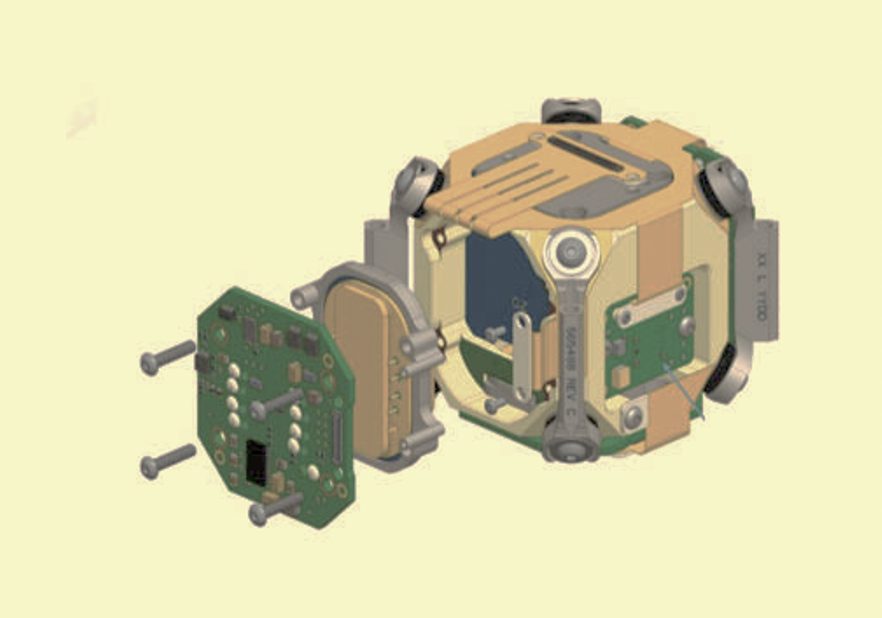New frontiers have opened up for line-of-sight communication, targeting, autonomous navigation, intelligence, surveillance and reconnaissance (ISR) and more, with the astonishing advances in inertial technology. Quartz micro-electromechanical (MEMS) inertial sensors use a one-piece, micromachined inertial sensing element to measure angular rotational velocity. Fundamentally, these sensors produce signal output proportional to the rate of rotation sensed.
A free webinar on July 21 explores the advantages of this technology, and those of closed-loop fiber optic gyros (FOGs): “Resetting the Bar on Inertial Sensor SWaP for Tactical and Navigation Applications.”
 Quartz MEMS have crashed past previous SWaP-c barriers in line-of-sight communication and targeting and autonomous navigation, where the key parameters are angle random walk (ARW) for gyros and velocity random walk (VRW) for accelerometers. They serve as the heart of a new generation of system solutions and offer the tools that make them an excellent choice for use by integrators and OEMs. The use of piezoelectric quartz material simplifies the sensing element, resulting in exceptional stability over temperature and time, and increases reliability and durability.
Quartz MEMS have crashed past previous SWaP-c barriers in line-of-sight communication and targeting and autonomous navigation, where the key parameters are angle random walk (ARW) for gyros and velocity random walk (VRW) for accelerometers. They serve as the heart of a new generation of system solutions and offer the tools that make them an excellent choice for use by integrators and OEMs. The use of piezoelectric quartz material simplifies the sensing element, resulting in exceptional stability over temperature and time, and increases reliability and durability.
Navigation- and reference-grade navigation are now possible at lower size, weight and power (SWaP) and cost levels than ever before. Technical breakthroughs in inertial technology have created new possibilities for gyroscopes and inertial measurement units (IMUs), enabling designers and system developers to achieve much higher precision than ever before.
Attendees will learn:
• How Quartz micro-electromechanical systems (MEMS) outperform silicon MEMS for autonomous devices and other navigation-grade applications. See the Quartz MEMS IMU that ranked #1 in a recent U.S. Department of Defense trade study.
• How Quartz MEMS gyros, IMU & INS/GPS and accelerometer technology is ideally suited to autonomous navigation.
• How higher bandwidth closed-loop fiber optic gyro (FOG) technology excels in north finding/keeping, optical far-targeting and extreme stabilizing precision for tactical grade applications.
• How FOG construction innovations produce form- and fit-compatible components with upgraded performance.
The panelists take a deep dive into the technologies that break frontiers on the key parameters of each area, with no sacrifice in performance—with improved performance in some cases. Attendees will get an inside-the-box look at exactly how these technologies work.
Higher bandwidth closed-loop FOGs excel in airborne optical targeting systems, ISR, aided autonomous navigation, and north-keeping, the key parameters are bandwidth, low ARW and low in-run bias.
Get a close-up engineer’s look at new products that improve performance in each application. See how they achieve performance at high stability (0.3 degree/hour) and low noise (0.02 degree/square root hour).
Attend this free webinar on
Wednesday, July 21, 2021 1:00 PM – 2:30 PM EDT
REGISTER NOW
Expert panelists:
Dr. Sergey A. Zotov is Senior Scientist at EMCORE with principal responsibility for the development of Quartz MEMS advanced micromachined inertial navigation sensors and systems. From 2014 to 2018 he was a Senior Engineer with General Electric Global Research, where he formed and served as the Principal Investigator (PI) of three DoD sponsored projects. Over the last 19 years, his focus has been on the research and development of MEMS gyroscopes and accelerometers. Dr. Zotov has authored over 50 peer-reviewed journal articles and international conference papers in inertial MEMS navigation, and he holds 10 U.S. patents. Dr. Zotov received the M.S. and Ph.D. degrees in mechanical engineering and control systems from Tula State University, Russia, in 1999 and 2002, respectively. From 2008 to 2014, he was a Post-Doctoral Scientist with the MicroSystems Laboratory, University of California, Irvine, CA, USA.
David Blumenfeld is Director of Fiber Optic Gyroscope (FOG) Research & Development for EMCORE Corporation since 2020. Mr. Blumenfeld joined EMCORE as the Lead Hardware Designer in 2016 for the Company’s development of the EMCORE-Hawkeye™ series FOG products and served as the Technical Lead on EMCORE’s EN-300 FOG Inertial Measurement Unit (IMU). He has over 10 years of experience in low-noise analog electronics design. Mr. Blumenfeld received his BS in Electrical Engineering from the University of California, Los Angeles, and his MS in Electrical Engineering from the University of Southern California. Prior to EMCORE, Mr. Blumenfeld worked at the University of Southern California Information Sciences Institute, where his research focused on developing low-cost prototyping manufacturing for IC designers.
David Hoyh is the Director of Navigation Sales & Marketing for EMCORE Corporation since 2009, where he currently leads revenue generation, customer development and new business pursuits, MARCOM and sales management. David received his business and marketing degrees from Western Michigan University in 1986. He has 30 years of experience in strategic planning, operations management, new business development, brand management, product development, national account and field sales, sales management, and commercial excellence in several different industry segments.
Unable to attend the live webinar on July 21st?
Register now and you will receive an invitation
to view on-demand at your convenience.






